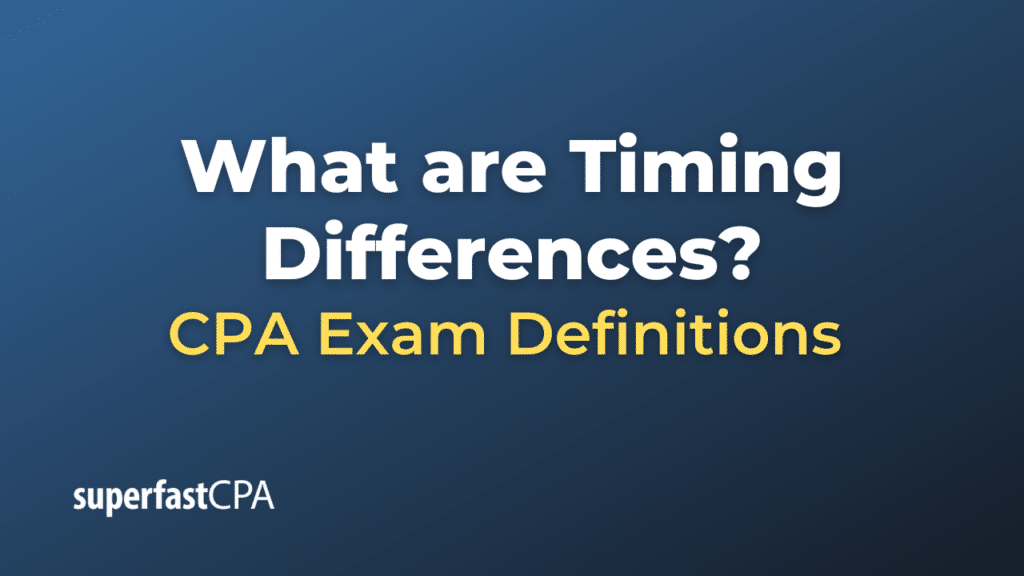Timing Differences
“Timing differences” is a term commonly used in the context of accounting, particularly when discussing the differences that arise between when an item is recognized for accounting purposes versus when it is recognized for tax purposes. These differences lead to temporary disparities between accounting income (or book income) reported in the financial statements and the taxable income reported to the tax authorities.
There are two primary types of timing differences:
- Temporary Differences: These are differences between the book value of an asset or liability and its tax base that will result in taxable or deductible amounts in the future. Temporary differences will eventually reverse over time. Examples include:
- Depreciation : If a company uses straight-line depreciation for accounting purposes but an accelerated method for tax purposes, a temporary difference arises. This is because the total depreciation over the asset’s life remains the same, but its recognition is faster for tax purposes than for book purposes in the initial years.
- Warranty Expenses: A company might recognize a warranty expense in its financial statements when it sells a product, but for tax purposes, the expense is only recognized when the warranty service is actually provided.
- Permanent Differences: These are differences between book income and taxable income that will not reverse in the future. They arise because certain items are recognized for financial accounting purposes but are never recognized for tax purposes, or vice versa. Examples include:
- Non-deductible expenses : Some expenses, like certain entertainment expenses, might be recorded in the company’s financial statements but are not deductible for tax purposes.
- Tax credits: A company might receive a tax credit that reduces its tax payable but doesn’t impact its book income.
The concept of timing differences is crucial because it leads to the creation of “deferred tax assets” or “deferred tax liabilities” on a company’s balance sheet.
- A deferred tax asset arises when a company expects to pay less tax in the future due to the reversal of temporary differences. It’s essentially a pre-payment of taxes.
- A deferred tax liability arises when a company expects to pay more tax in the future when the temporary differences reverse.
Understanding timing differences is essential for accurate financial reporting and for comprehending the nuances of a company’s tax position.
Example of Timing Differences
Let’s delve into a more detailed example that illustrates timing differences using the concept of depreciation.
Scenario: Delta Machinery Inc.
Background: Delta Machinery Inc. purchases a machine for $100,000. For accounting (or book) purposes, it uses the straight-line method of depreciation over 10 years, resulting in a yearly depreciation expense of $10,000. However, for tax purposes, Delta is allowed to use an accelerated depreciation method, which results in a $20,000 depreciation expense for the first year.
Year 1 Calculations:
- Accounting (Book) Depreciation:
Straight-line method: $100,000 ÷ 10 years = $10,000 - Tax Depreciation:
Accelerated method (just for illustration): $20,000
Timing Difference:
In Year 1, the timing difference due to depreciation is: $20,000 (tax) – $10,000 (book) = $10,000
Implications:
- In Year 1, Delta will report a higher depreciation expense for tax purposes than for book purposes. This means they will have a lower taxable income than accounting income for that year.
- This difference will lead to a deferred tax asset or liability. Given that Delta is reporting a higher expense for tax than for accounting, it’s essentially “overpaying” its taxes now relative to its accounting income. This “overpayment” will reverse in future years when the accelerated tax depreciation is less than the straight-line book depreciation. Therefore, Delta will recognize a deferred tax asset on its balance sheet.
As years progress, the accelerated method for tax will result in lower depreciation compared to the straight-line method until the machine is fully depreciated for tax purposes. This will reverse the initial timing difference as the company will now be recognizing less depreciation for tax than for accounting. Over the entire life of the machine, the total depreciation will be the same for both tax and book purposes; it’s just recognized differently over time.
This example highlights how timing differences can arise and their implications for financial reporting and tax obligations.













